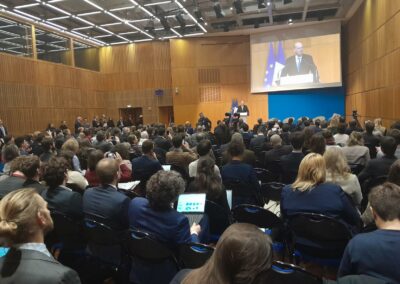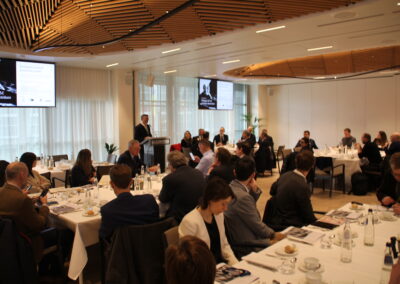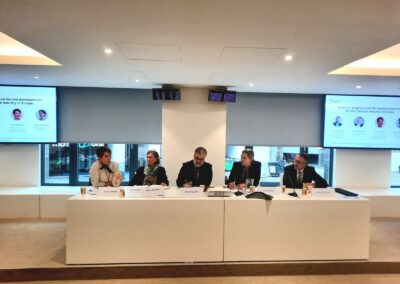Building smarter climate policy
We analyse emissions data and research decarbonisation pathways to advocate evidence-based policies
We are a think tank conducting data-driven and evidence-based advocacy to improve EU climate policy.
Our topics
EU Emissions Trading System
We conduct research on the EU ETS to find concrete ways to reduce emissions and advocate for efficient carbon pricing mechanisms.
Carbon Border Adjustment Mechanism
We support a strong CBAM to phase out the allocation of free emission allowances, address carbon leakage, and accelerate global climate action.
Industry
Climate Financing
We analyse EU funding initiatives driving climate innovation and industrial decarbonisation. Ensuring revenues from the EU ETS and CBAM are well spent.
Carbon Dioxide Removal
We conduct research on CDR to ensure those technologies are incentivised properly, and help – rather than hinder – the EU on its path to climate neutrality.
Our publications
We produce data-driven and evidence-based reports, briefs and policy recommendations on EU decarbonisation.
The CBAM dividend for Namibia and Ghana
This research note shows that Namibia and Ghana are likely to benefit from the CBAM, as EU price increases linked to the EU ETS outweigh CBAM fees under current exports. It also sets out transparent transformation scenarios, based on announced industrial projects, to show how expanded and lower-emissions production could further increase export revenues over time.
Steel labelling: Beyond the sliding scale
As EU policymakers debate how to certify low-carbon steel, Sandbag’s new briefing analyses the “sliding scale” method — and outlines why it may hinder rather than help decarbonisation. A new model is proposed based on product-specific benchmarks, multi-tier ratings, and circularity incentives.
Chemicals in the CBAM: Time to step up
Sandbag’s latest brief explains why the EU CBAM must be expanded to cover key chemical value chains. With chemicals and refinery products responsible for 30% of industry emissions, phased inclusion is critical to prevent carbon leakage and phase out free allowances.
Our data tools
Our in-house tools provide the insights needed to develop data-driven climate policies.
CBAM Simulator
Assess how the EU Carbon Border Adjustment Mechanism (CBAM) could impact trade between the EU and non-EU countries.
Carbon price viewer
Check and analyse the evolution of the EU carbon price over time.
EU ETS Dashboard
Explore sector-specific emissions data within the EU Emissions Trading System at various levels of granularity.
EU ETS Simulator
Analyse the impact of policy adjustments on the EU ETS.
EU ETS + CDR Simulator
Explore how integrating Carbon Dioxide Removals (CDR) could reshape the EU ETS between 2031–2040.
Public outreach & advocacy
High-Level Conference on the Carbon Border Adjustment Mechanism (CBAM)
On 12 February 2025, we joined experts from the European Commission, think tanks and industry to discuss possible evolutions of the CBAM in an event organised by France’s Direction Générale du Trésor.
China International Import Expo
On 7 November 2024, we presented at the China International Import Expo on “Recent Developments in the EU Carbon Border Adjustment Mechanism (CBAM): Outlook after the Transitional Period.”
Closing Loopholes: Making CBAM Work for Aluminium
On 12 February 2025, we joined a high-level panel discussion at the European Parliament about a potential loophole for aluminium products – which could happen if emissions from aluminium scrap weren’t accounted for in the CBAM.
Questions & answers
Why the name ‘Sandbag’?
Sandbag symbolises the coordinated action people take to protect themselves and others in the face of extreme weather events. Likewise, we work to unite stakeholders to protect the environment, society, and economy from the risks of ineffective climate action.
Are you a think tank or an NGO?
We are a think tank that produces research, tools, and evidence for decision-making. But we also actively advocate for change, making us an “advocacy think tank”.
How are you funded?
Our work is supported by foundation grants and individual donations from those who share our commitment to advancing effective climate policies. We also occasionally undertake consultancy work that aligns with our mission to drive efficient emissions reductions. For instance, supporters have included the European Climate Foundation, the European Commission, Energy Foundation China, KR Foundation, WWF, Climate Action Network Europe, and Environmental Defense Fund Europe.
What is your legal statute?
We are a Belgian not-for-profit organisation (Association Sans But Lucratif – ASBL). Any financial surplus is reinvested into Sandbag. Our registration number is 0707.935.890.
Join us in building smarter climate policies!

WHAT WE DO
TOOLS
PUBLICATIONS
NEWSLETTER
Mundo-b Matogné. Rue d’Edimbourg 26, Ixelles 1050 Belgium.
Sandbag is a not-for-profit (ASBL) organisation registered in Belgium under the number 0707.935.890.
EU transparency register no. 277895137794-73.
VAT: BE0707935890.







